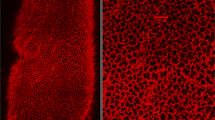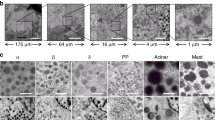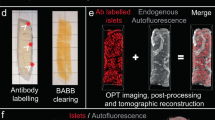Abstract
A CYTOLOGICAL study has been carried out on exocrine cells of the pancreas of the mouse with the aid of the electron microscope. The tissue was taken from animals aged two to three months and fixed in osmic acid buffered1 to a pH of 7.4. It was then embedded in n-butyl methacrylate and sections about 400–800 A. thick were cut. Similar tissue, also fixed in buffered osmic acid, was embedded in gelatine for sectioning and examination by light microscopy in order to compare the effects of osmium fixation with those obtained by other fixatives employed in previous studies2,3.
This is a preview of subscription content, access via your institution
Access options
Subscribe to this journal
Receive 51 print issues and online access
$199.00 per year
only $3.90 per issue
Buy this article
- Purchase on Springer Link
- Instant access to full article PDF
Prices may be subject to local taxes which are calculated during checkout
Similar content being viewed by others
References
Palade, G. E., J. Exp. Med., 95, 285 (1952).
Lacy, D., J. Roy. Micr. Soc., 73, 179 (1954).
Lacy, D., J. Roy. Micr. Soc. (in tho press).
Weiss, J., and Lansing, A. I., Proc. Soc. Exp. Biol. Med., 82, 460 (1953).
Ludford, R. J., Brit. J. Cancer, 8, 112 (1953).
Author information
Authors and Affiliations
Rights and permissions
About this article
Cite this article
CHALLICE, C., LACY, D. Fine Structure of Exocrine Cells of the Pancreas. Nature 174, 1150–1151 (1954). https://doi.org/10.1038/1741150a0
Issue Date:
DOI: https://doi.org/10.1038/1741150a0
This article is cited by
-
Alterations of astrocytic organelles in various lipidoses and allied diseases
Acta Neuropathologica (1971)
-
The role of the Golgi complex in the formation of secretion in the test cells of the follicle of the tunicate, Ciona
Zeitschrift f�r Zellforschung und Mikroskopische Anatomie (1965)
-
Electron microscopic studies on the neurosecretory system in lepidoptera
Zeitschrift f�r Zellforschung und Mikroskopische Anatomie (1961)
-
Fine Structure of the Neurosecretory System in Lepidoptera
Nature (1960)
-
Der Arbeitszyklus im Pankreas und die Entstehung der Eiwei�e
Die Naturwissenschaften (1958)
Comments
By submitting a comment you agree to abide by our Terms and Community Guidelines. If you find something abusive or that does not comply with our terms or guidelines please flag it as inappropriate.



